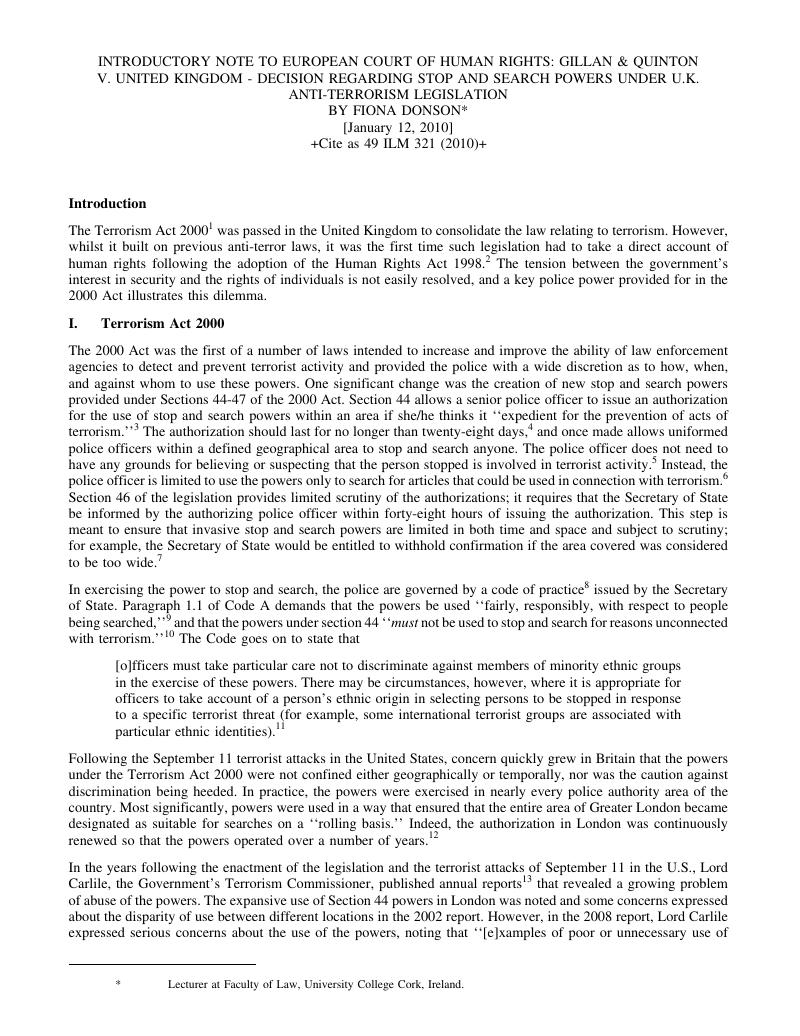Published online by Cambridge University Press: 27 February 2017

* This text was reproduced and reformatted from the text available at the European Court of Human Rights website (visited March 29, 2010) http://cmiskp.echr.coe.int/tkp197/view.asp?item=1&portal=hbkm&action=html&highlight=Gillan&sessionid=50212818&skin=hudoc-en.
1 Terrorism Act 2000, c. 11, available at http://www.opsi.gov.uk/acts/acts2000/ukpga_20000011_en_1 [hereinafter Terrorism Act 2000].
2 Human Rights Act 1998, c. 42, available at http://www.opsi.gov.uk/acts/acts1998/ukpga_19980042_en_1.
3 See Terrorism Act 2000, supra note 1, § 44(3) & (4).
4 Id. § 46.
5 Id. § 45(1)(b). These provisions went beyond the normal stop and search powers that operate under Section 1 of the Police and Criminal Evidence Act 1984, which require that the police officer have a “reasonable suspicion” that the individual possesses a “prohibited article” or is about to or has committed a crime.
6 Id. § 45(1)(a).
7 However, the Secretary of State is not entitled to alter the geographical coverage
8 The codes were first issued in 2003 but revised and renewed. See Police and Criminal Evidence Act 1984 Codes of Practice (Order), 2008 (Eng.), available at http://police.homeoffice.gov.uk/operational-policing/powers-pace-codes/pace-codeintro/ (Code A governs the operation of sections under the Terrorism Act 2000).
9 Id. ¶ 1.1.
10 Id. ¶ 2.25 (emphasis added).
11 Id.
12 Lord Carlile, Report on the Operation in 2002 and 2003 of the Terrorism Act 2000, ¶ 79 (2004).
13 Section 126 of the Terrorism Act 2000 required that the Secretary of State lay a report before Parliament at least once every twelve months. Terrorism Act 2000, supra note 1.
14 Lord Carlile, Report on the Operation in 2008 of the Terrorism Act 2000, ¶ 140 (June 2009).
15 Id. ¶¶ 140-149.
16 United Kingdom Ministry of Justice, Statistics on Race and the Criminal Justice System 2007/8 (Apr. 2009).
17 Gillan & Quinton v. United Kingdom, 2009 Eur. Ct. H.R. 28.
18 R v. Comm’r of Police for the Metropolis, [2006] UKHL 12.
19 Id. ¶¶ 14-15 (Lord Bingham).
20 Id. ¶¶ 21-26. The court found that even if it did it amount to a deprivation of liberty, it could be justified under Article 5(1)(b): “the lawful arrest or detention of a person for noncompliance with the lawful order of a court or in order to secure the fulfilment of any obligation prescribed by law.”
21 Id. ¶¶ 27-29. The court found that the power was a proportionate response to the danger of terrorism.
22 See Adam Tomkins, The Role of the Courts in the Political Constitution, 60 U. Toronto L.J. 1 (2010); Daniel Moeckli, Stop and Search Under the Terrorism Act 2000: A Comment on R (Gillan) v Commissioner of Police for the Metropolis, 70(4) M.L.R. 654 (2007).
23 R v. Comm’r of Police, supra note 18, ¶ 57.
24 Peck v. United Kingdom, (2003) 36 E.H.R.R. 719. This case involved still photographs taken from Closed Circuit Television (CCTV) footage of a man attempting suicide. The footage was later used by a local council to illustrate the effectiveness of CCTV. The Court held that disclosure of the footage was a disproportionate interference with the applicant’s private life under Article 8.
25 Gillan & Quinton, supra note 17, ¶ 63.
26 Id. ¶ 77.
27 Id. ¶ 79.
28 Id. ¶ 84. The figures from the Ministry of Justice showed a total of 33,177 searches in 2004/5, 44,545 in 2005/6, 37,000 in 2006/7, and 117, 278 in 2007/8.
29 Id. ¶ 85.
30 Id.
31 Id. ¶ 57.
32 Id. This is in contrast to the decision of Lord Bingham in the House of Lords. He concluded that the brief nature of stop and search and the lack of handcuffs/confinement meant there was no “deprivation of liberty.” He held that the process was more akin to being “kept from proceeding or kept waiting.” R. v. Comm’r of Police, supra note 18, ¶ 19.
33 UK Government Appeals European Court Ruling on Section 44, Brit. J. Photography, Apr. 13, 2010, available at http://www.bjp-online.com/public/showPage.html?page=874193.
34 Joint Committee on Human Rights, Counter-Terrorism Policy and Human Rights (17th Report): Bringing Human Rights Back In, at 3 (Mar. 25, 2010).
35 Martin Bentham, Scrap Stop and Search Law Says Terror Watchdog, Evening Standard, Mar. 4, 2010, available at http://www.thisislondon.co.uk/standard/article-23811968-scrap-stop-and-search-law-says-terror-watchdog.do.